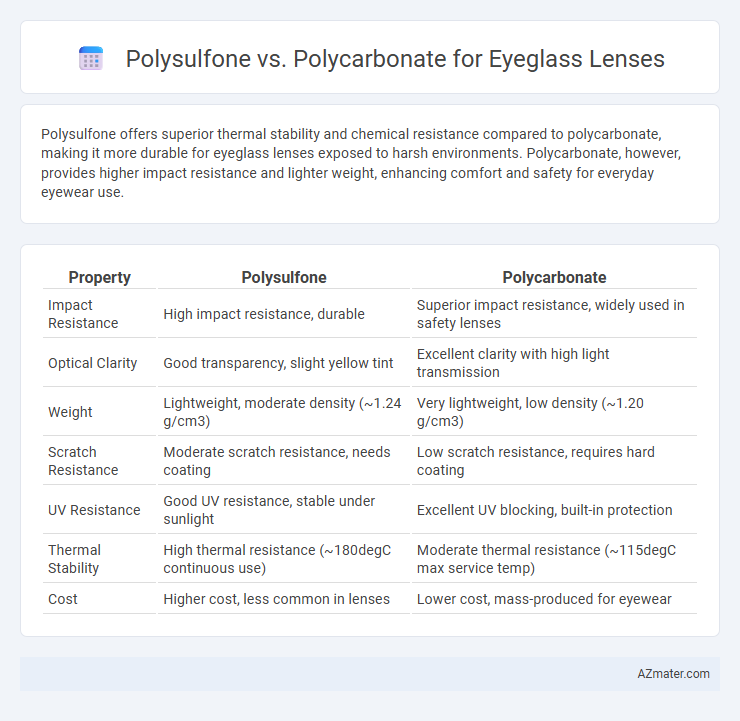Polysulfone offers superior thermal stability and chemical resistance compared to polycarbonate, making it more durable for eyeglass lenses exposed to harsh environments. Polycarbonate, however, provides higher impact resistance and lighter weight, enhancing comfort and safety for everyday eyewear use.
Table of Comparison
| Property | Polysulfone | Polycarbonate |
|---|---|---|
| Impact Resistance | High impact resistance, durable | Superior impact resistance, widely used in safety lenses |
| Optical Clarity | Good transparency, slight yellow tint | Excellent clarity with high light transmission |
| Weight | Lightweight, moderate density (~1.24 g/cm3) | Very lightweight, low density (~1.20 g/cm3) |
| Scratch Resistance | Moderate scratch resistance, needs coating | Low scratch resistance, requires hard coating |
| UV Resistance | Good UV resistance, stable under sunlight | Excellent UV blocking, built-in protection |
| Thermal Stability | High thermal resistance (~180degC continuous use) | Moderate thermal resistance (~115degC max service temp) |
| Cost | Higher cost, less common in lenses | Lower cost, mass-produced for eyewear |
Introduction to Eyeglass Lens Materials
Polysulfone and polycarbonate are advanced thermoplastic materials commonly used for eyeglass lenses due to their durability and optical clarity. Polysulfone offers excellent heat resistance and chemical stability, making it suitable for lenses requiring high impact strength and long-term performance. Polycarbonate is renowned for its lightweight nature, superior impact resistance, and UV protection, making it a popular choice for everyday eyewear and safety glasses.
Overview of Polysulfone Lenses
Polysulfone lenses offer exceptional impact resistance and high thermal stability, making them ideal for durable eyeglass applications. Their lightweight nature and excellent chemical resistance provide enhanced comfort and long-lasting clarity, even under harsh conditions. These lenses also exhibit superior dimensional stability compared to polycarbonate, reducing distortion and maintaining optical performance over time.
Overview of Polycarbonate Lenses
Polycarbonate lenses are highly favored in eyeglass manufacturing due to their exceptional impact resistance and lightweight properties, making them ideal for safety glasses and children's eyewear. These lenses offer superior UV protection by blocking 100% of harmful UV rays, which helps prevent eye damage and cataracts. Compared to polysulfone, polycarbonate provides better optical clarity and higher resistance to shattering, enhancing both durability and visual comfort.
Optical Clarity Comparison
Polysulfone lenses offer excellent optical clarity with high light transmittance and minimal distortion, making them suitable for precise vision needs. Polycarbonate lenses provide good optical clarity but can have slightly lower light transmission and more chromatic aberration compared to polysulfone. Both materials are impact-resistant, yet polysulfone lenses typically deliver sharper visual acuity for eyeglass wearers.
Impact Resistance and Durability
Polysulfone lenses offer exceptional impact resistance with high tensile strength and excellent chemical stability, making them highly durable for everyday use. Polycarbonate lenses are renowned for their superior impact resistance, being nearly unbreakable and lightweight, which enhances comfort and safety in eyeglasses. Both materials provide durability, but polycarbonate surpasses polysulfone in impact resistance, making it more suitable for high-risk environments and active lifestyles.
Weight and Comfort Analysis
Polysulfone eyeglass lenses are lightweight with a density around 1.29 g/cm3, providing exceptional comfort for extended wear due to reduced pressure on the nose and ears. In contrast, polycarbonate lenses have a slightly higher density of approximately 1.20 g/cm3 but offer superior impact resistance, making them durable while still maintaining a comfortable fit. Both materials balance comfort and weight effectively, though polysulfone lenses typically result in a lighter, more comfortable eyeglass experience for users seeking prolonged daily wear.
UV Protection Capabilities
Polysulfone lenses offer moderate UV protection by inherently filtering UV radiation up to approximately 280 nm, making them suitable for general daily wear. Polycarbonate lenses provide superior UV protection, blocking 100% of UVA and UVB rays, with effective shielding up to 400 nm, which is critical for preventing eye damage from prolonged sun exposure. For optimal UV defense in eyeglass lenses, polycarbonate is preferred due to its comprehensive spectrum coverage and inherent impact resistance.
Cost Differences
Polysulfone lenses generally cost less than polycarbonate lenses due to lower raw material prices and simpler manufacturing processes. Polycarbonate, offering superior impact resistance and optical clarity, commands a higher price reflecting its advanced properties. Budget-conscious consumers often choose polysulfone for affordability, while polycarbonate suits those prioritizing durability despite the higher expense.
Common Applications in Eyewear
Polysulfone lenses are frequently used in safety glasses and industrial eyewear due to their high impact resistance and excellent thermal stability. Polycarbonate lenses dominate the consumer eyewear market, especially for sports and children's glasses, offering lightweight comfort combined with superior impact protection. Both materials provide UV protection, but polycarbonate's optical clarity and scratch-resistant coatings make it a preferred choice for everyday prescription eyewear.
Conclusion: Choosing the Right Lens Material
Polysulfone offers exceptional chemical resistance and high heat tolerance, making it ideal for eyeglass lenses in demanding environments. Polycarbonate provides superior impact resistance and lightweight comfort, preferred for active lifestyles and safety eyewear. Selecting the right lens material depends on prioritizing durability and chemical stability with Polysulfone or impact protection and lightweight design with Polycarbonate.

Infographic: Polysulfone vs Polycarbonate for Eyeglass Lens
 azmater.com
azmater.com